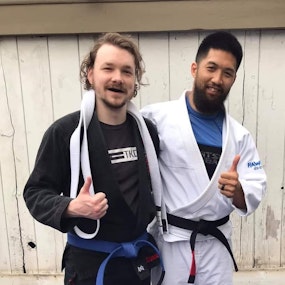In episode 39 of the Combat Learning Podcast, my friend Daniel Marino made a critical observation about the karate community:
“It’s about looking good, not learning how to fight.”
Now, if you’re a part of the so-called “practical karate” or “practical bunkai” movement, you might think that you are exempt from this statement…but you’re not.
Dan wasn’t just talking about the most traditional of the traditionalists. He was talking about the practical karate people, too.
I haven’t addressed it specifically yet, but I have touched on the practical karate and taekwondo crowd from time to time…
Generally, I don’t think they’re improving anything. Overall, it just appears to be more of the same old same old with a slightly different aesthetic.
Which leads me to the point of this article: all of karate, including practical karate, is based on aesthetics. Yes, even the “self-defense” oriented training.
All designations of “practical” and “realistic” from the karate community appear to be statements of personal taste. It’s not a matter of understanding of what’s going on at a fundamental, dynamical level.
Let’s explore this in more detail.
What Does “Realistic” Mean to Karate and Taekwondo People?
On the Adaptable Athlete Podcast, I made an observation about a strange, unspoken, and pervasive view of “realistic” adopted by martial artists.
In a word, they think of realism like the way you’d say a painting is realistic. Or a movie script – a piece of dialog.
If you pay attention to the way people talk in movies, dialog is only realistic insofar as it convinces you that it’s real people talking. It’s not how people actually talk. They’re circular, erratic, their pace and peak is all over the place…
It sounds realistic in one sense, but it does not represent how people actually talk. It’s stage magic.
It is the same thing with a painting. A painting looks realistic, but it’s not like a direct photograph or, more importantly, you in person perceiving the real thing. You can always tell it’s a painting.
Realism should actually refer to realistic behavior. Whether self-defense or fighting, it’s never scripted or cooperative. Realistic behavior in martial arts training, then, should never be scripted and never be cooperative.
Live training often looks exactly like the real thing. But never, at any point, does dead training ever fool our eyes.
The difference even between sparring and bunkai applications is always apparent. There is no gray area.
Martial artists of all types, but especially karate and taekwondo people, seem to judge practicality and realism based on an aesthetic quality – a personal and unexamined sense of stagecraft or “what it should look like.”
But strangely, that quality has more to do with how you would judge a piece of art than how you would identify a real fight.
Is there a Difference Between Realistic Fight Choreography and Rote Drilling?
“That’s movie martial arts,” they say. Their voices are as disdainful as they are dismissive.
But we’ve all seen a movie where the fight scenes appeared realistic. They were not overly stylized. They looked like they could have occurred in real life. They are realistic in the way paintings are realistic.
With this in mind, there’s a fascinating and uncomfortable question to be asked:
What is the real difference between realistic fight choreography and a drill like one steps?
One looks realistic, but is not considered real training (choreography); the other does not look realistic, but is almost universally considered essential training among traditional martial artists (one steps).
Whether the exercise is one step sparring or not doesn’t matter – it could be a compliant guard passing sequence or a kickboxing combination with a willing partner. The basic problem is the same.
What’s interesting about one step sparring is that it amplifies the problem of appearance-based assessments of realism.
The proposition would appear absurd on its face to a traditional martial artist. But realistic fight choreography checks all the right boxes to prequalify itself as “realistic” training, while one steps obviously do not.
Practical Karate people don’t know why they do some things and not others
To describe the differences between the two, a traditional training apologist might reply:
- If I throw a punch in film choreography, it is deliberately wide, high, or short so that the actor is never truly threatened. If he just stood there and I did my part right, he would never be hit.
- If I threw a punch in your scripted training drill and the receiver did not move, parry, duck, dodge, dip, dive, or whatever the script required, the receiver would be hit.
(I must note here that these are real replies from real adherents of traditional training methods. I did not simply imagine them.)
An interesting observation is emerging here. There is no limiting principle, operating theory, or framework being used to understand which elements of performative “realism” are useful for training and which are not.
Of course, if you’ve put any thought into the above two arguments, you have already concluded that they are inaccurate to both the reality of fighting and the way training is actually conducted.
I responded to those points:
- In the normal course of training in a sterile fashion, everyone throws with some or all possible artificialities: wide arcs, intentionally off target, stop short, slowness, less power, no follow-up or setup, etc. It’s not true that people actually, consistently throw strikes with realistic trajectories, ranging, or speed, among other things. But even if it were the case that the technique, range, and intent were realistic, the speed and power almost certainly are not and neither is the follow-up to that technique. Something always has to give – but what should give and what shouldn’t?
- High level, well-trained strikers throw wide arcing strikes all the time; and so do people who pose a self-defense threat in everyday life. So you constrain them out of training because they do not appear realistic to you, but it does not reflect real life.
It is strange to assign no value to one artificiality but assign great salience to another. Again, what is the rubric being used to determine which artificial features of training are fine and which are not?
These are the same people who will claim that sport training is nearly useless, or at least suboptimal, to learn how to defend yourself “in real life.” Yet the epistemology of how they come to know what is “practical” or “realistic” is not just broken but apparently nonexistent.
Well okay, but the intentions between the two are different…
Some will say that the intention between the two exercises is different, and thus their value for training is differentiated that way.
That’s fine, sounds very smart, except that does not explain any mechanical or technical difference between the two. It does not explain why. It’s literally just a word with no connection to whether or not the training exercise is good.
This reveals another problem with traditional martial artists: magic words.
This is an extremely convoluted and expansive topic far beyond the scope of this article. Suffice it to say, kata apologists are accustomed to saying a bunch of smart words in defense of kata training that don't mean anything or correspond to any explanation or mechanism for what they do.
They say things like:
“It helps targeting and accuracy.”
“It improves timing.”
“It works speed.”
“It creates proprioception.”
"It teaches fundamentals."
All things that make zero sense in an isolated exercise (targeting, accuracy, timing, fundamentals) or don’t help directly with learning fighting skills nor preparing for sparring (proprioception).
I know they’re smart words and not smart arguments because half of them don’t make sense, and the other half fall apart as soon as you ask one or two questions.
Conclusion
Among traditional martial artists, there is neither a consistent nor objective way to determine what artificialities are tolerable for valuable training (e.g., scriptedness, compliance) and which are not.
It seems to me people mostly decide what's likely to be practical or what is realistic based on how it appears to them, especially with regard to bunkai application. It's not just subjective but also arbitrary.
For example, one interlocutor of mine mentioned in response to me that he would not throw punches in exaggerated arcs in training in an attempt to make that sequence more realistic.
But this is a phenomenon almost exclusive to artificial training. High level, well-trained strikers throw wide arcing strikes all the time; and so do people who pose a self-defense threat in everyday life. He constrained them out of training because they do not appear realistic to him, but it does not reflect real life.
This appearance-based approach to determining technique/drilling practicality opens the door to some really silly conclusions, even to traditional martial artists:
For example, you must eventually reach the conclusion that realistic-appearing movie choreography could actually be more realistic training than one step sparring. Or that it's potentially a valid source of self-defense instruction in merit of a certain aesthetic quality.
It's clear that some tradeoffs have to be made to keep training safe, but the way it's sorted through right now is entirely arbitrary and totally unexamined. I developed the SLT framework for this purpose, but people who use broadly traditional approaches to skill acquisition don't even seem aware of the problem yet.
If the practical karate and taekwondo communities are going to move forward, they must think through why they tolerate some artificialities in training and not others. Then, they must develop an objective, consistent, empirically-supported framework for sorting out their training methods accordingly.
My part in solving this problem is to continue to raise awareness by asking these sorts of questions. I won’t make many friends while doing it, but I care more about elevating martial arts coaching than having a pristine reputation.





